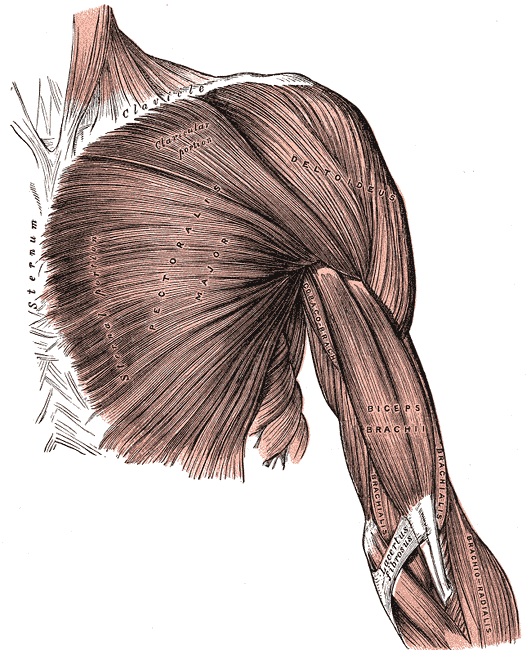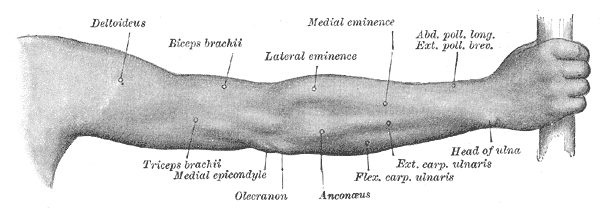[1]
Hyland S, Charlick M, Varacallo M. Anatomy, Shoulder and Upper Limb, Clavicle. StatPearls. 2024 Jan:():
[PubMed PMID: 30252246]
[3]
Mostafa E, Imonugo O, Varacallo M. Anatomy, Shoulder and Upper Limb, Humerus. StatPearls. 2024 Jan:():
[PubMed PMID: 30521242]
[6]
Tiwana MS, Charlick M, Varacallo M. Anatomy, Shoulder and Upper Limb, Biceps Muscle. StatPearls. 2024 Jan:():
[PubMed PMID: 30137823]
[7]
McCausland C, Sawyer E, Eovaldi BJ, Varacallo M. Anatomy, Shoulder and Upper Limb, Shoulder Muscles. StatPearls. 2024 Jan:():
[PubMed PMID: 30521257]
[9]
Peterson SL, Rayan GM. Shoulder and upper arm muscle architecture. The Journal of hand surgery. 2011 May:36(5):881-9. doi: 10.1016/j.jhsa.2011.01.008. Epub
[PubMed PMID: 21527142]
[10]
Klarner T, Barss TS, Sun Y, Kaupp C, Zehr EP. Preservation of common rhythmic locomotor control despite weakened supraspinal regulation after stroke. Frontiers in integrative neuroscience. 2014:8():95. doi: 10.3389/fnint.2014.00095. Epub 2014 Dec 22
[PubMed PMID: 25565995]
[11]
Dyrna F, Kumar NS, Obopilwe E, Scheiderer B, Comer B, Nowak M, Romeo AA, Mazzocca AD, Beitzel K. Relationship Between Deltoid and Rotator Cuff Muscles During Dynamic Shoulder Abduction: A Biomechanical Study of Rotator Cuff Tear Progression. The American journal of sports medicine. 2018 Jul:46(8):1919-1926. doi: 10.1177/0363546518768276. Epub 2018 May 9
[PubMed PMID: 29741391]
[12]
Lee AS, Harris J, Bate M, Vijayraghavan K, Fisher L, Tajbakhsh S, Duxson M. Initiation of primary myogenesis in amniote limb muscles. Developmental dynamics : an official publication of the American Association of Anatomists. 2013 Sep:242(9):1043-55. doi: 10.1002/dvdy.23998. Epub 2013 Jul 22
[PubMed PMID: 23765941]
[13]
Smith CD, Booker SJ, Uppal HS, Kitson J, Bunker TD. Anatomy of the terminal branch of the posterior circumflex humeral artery: relevance to the deltopectoral approach to the shoulder. The bone & joint journal. 2016 Oct:98-B(10):1395-1398
[PubMed PMID: 27694595]
[14]
Leechavengvongs S, Teerawutthichaikit T, Witoonchart K, Uerpairojkit C, Malungpaishrope K, Suppauksorn S, Chareonwat B. Surgical anatomy of the axillary nerve branches to the deltoid muscle. Clinical anatomy (New York, N.Y.). 2015 Jan:28(1):118-22. doi: 10.1002/ca.22352. Epub 2014 Feb 4
[PubMed PMID: 24497068]
[15]
Kayikçioglu A, Celik HH, Yilmaz E. An anatomic variation of the deltoid muscle (case report). Bulletin de l'Association des anatomistes. 1993 Sep:77(238):15-6
[PubMed PMID: 8148518]
Level 3 (low-level) evidence
[16]
Kamburoğlu HO, Boran OF, Sargon MF, Keçik A. An unusual variation of deltoid muscle. International journal of shoulder surgery. 2008 Jul:2(3):62-3. doi: 10.4103/0973-6042.42201. Epub
[PubMed PMID: 20300317]
[17]
Bunker TD, Cosker TD, Dunkerley S, Kitson J, Smith CD. Anatomical variations of the deltoid artery: relevance to the deltopectoral approach to the shoulder. The bone & joint journal. 2013 May:95-B(5):657-9. doi: 10.1302/0301-620X.95B5.31408. Epub
[PubMed PMID: 23632676]
[20]
Gadea F, Bouju Y, Berhouet J, Bacle G, Favard L. Deltopectoral approach for shoulder arthroplasty: anatomic basis. International orthopaedics. 2015 Feb:39(2):215-25. doi: 10.1007/s00264-014-2654-x. Epub 2015 Jan 16
[PubMed PMID: 25592830]
[21]
Chou YC, Tseng IC, Chiang CW, Wu CC. Shoulder hemiarthroplasty for proximal humeral fractures: comparisons between the deltopectoral and anterolateral deltoid-splitting approaches. Journal of shoulder and elbow surgery. 2013 Aug:22(8):e1-7. doi: 10.1016/j.jse.2012.10.039. Epub 2013 Jan 16
[PubMed PMID: 23333173]
[22]
Harmer LS, Crickard CV, Phelps KD, McKnight RR, Sample KM, Andrews EB, Hamid N, Hsu JR. Surgical Approaches to the Proximal Humerus: A Quantitative Comparison of the Deltopectoral Approach and the Anterolateral Acromial Approach. Journal of the American Academy of Orthopaedic Surgeons. Global research & reviews. 2018 Jun:2(6):e017. doi: 10.5435/JAAOSGlobal-D-18-00017. Epub 2018 Jun 13
[PubMed PMID: 30211395]
[23]
Todisco V, Cirillo G, Capuano R, d'Ambrosio A, Tedeschi G, Gallo A. Stimulated single-fiber electromyography (sSFEMG) in Lambert-Eaton syndrome. Clinical neurophysiology practice. 2018:3():148-150. doi: 10.1016/j.cnp.2018.07.001. Epub 2018 Aug 13
[PubMed PMID: 30215026]
[24]
Kohara N, Kuzuhara S, Kaneko T, Yamanouchi H, Toyokura Y. [Two cases of post-poliomyelitis muscular atrophy]. Rinsho shinkeigaku = Clinical neurology. 1989 Jul:29(7):919-23
[PubMed PMID: 2805516]
Level 3 (low-level) evidence
[25]
Israeli E, Agmon-Levin N, Blank M, Shoenfeld Y. Macrophagic myofaciitis a vaccine (alum) autoimmune-related disease. Clinical reviews in allergy & immunology. 2011 Oct:41(2):163-8. doi: 10.1007/s12016-010-8212-4. Epub
[PubMed PMID: 20882368]


